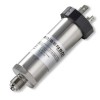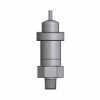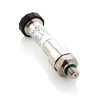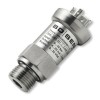High resolution pressure transducers with an analog voltage output for detecting very small changes in pressure or measuring pressure to a high precision.
Typically a 16 bit digital amplifier is utilised to provide a high resolution output to make the most of the available resolution from analog to digital converters in data acquisition cards and other ADC instrumentation devices.
Products
 DMP331i High Accuracy Pressure Transmitter - High precision pressure transmitter with an accuracy of 0.1%FS BSL NLHR and digitally adjustable pressure ranges from 400mb up to 40 bar gauge & absolute.
DMP331i High Accuracy Pressure Transmitter - High precision pressure transmitter with an accuracy of 0.1%FS BSL NLHR and digitally adjustable pressure ranges from 400mb up to 40 bar gauge & absolute. DMP333i Rangeable High Pressure Precision Transducer - High performance transducer with adjustable scaling for modifying the pressure range for different applications. Ranges from 0-60 bar up to 0-600 bar.
DMP333i Rangeable High Pressure Precision Transducer - High performance transducer with adjustable scaling for modifying the pressure range for different applications. Ranges from 0-60 bar up to 0-600 bar.
Applications
 15psig 0-10Vdc output pressure sensor for nitrogen filled antenna line leak testing use - A high resolution analog voltage output pressure sensor for nitrogen filled antenna line leak testing use to measure pressure of nitrogen over a range of 0 to 15 psi g from the 1/4 NPT male process connection, and sending the corresponding 0-10Vdc signal through the DIN plug electrical connection.
15psig 0-10Vdc output pressure sensor for nitrogen filled antenna line leak testing use - A high resolution analog voltage output pressure sensor for nitrogen filled antenna line leak testing use to measure pressure of nitrogen over a range of 0 to 15 psi g from the 1/4 NPT male process connection, and sending the corresponding 0-10Vdc signal through the DIN plug electrical connection. 25 psig range high resolution 0-10Vdc output air pressure sensor for leak testing use - A high resolution gauge pressure sensor for leak testing use to measure pressure of air over a range of 0 to 25 psi g from the 1/4 NPT male process connection, and sending the corresponding 0-10Vdc signal through the integral cable electrical connection.
25 psig range high resolution 0-10Vdc output air pressure sensor for leak testing use - A high resolution gauge pressure sensor for leak testing use to measure pressure of air over a range of 0 to 25 psi g from the 1/4 NPT male process connection, and sending the corresponding 0-10Vdc signal through the integral cable electrical connection. Leak testing at 0.5 bar to detect 200 Pascal pressure drop - The parts have to be checked at 0.5bar pressure. We are interested in measuring leakage which results in a drop of 200Pa pressure over a period of 10 sec.
Leak testing at 0.5 bar to detect 200 Pascal pressure drop - The parts have to be checked at 0.5bar pressure. We are interested in measuring leakage which results in a drop of 200Pa pressure over a period of 10 sec. High resolution minus 150 mbar range pressure transducer - We need to measure vacuum difference from zero to minus 150mbar below atmospheric pressure.
High resolution minus 150 mbar range pressure transducer - We need to measure vacuum difference from zero to minus 150mbar below atmospheric pressure.
 23 to 33 inHg barometric range pressure transducer with a 10 volt hi-resolution output
23 to 33 inHg barometric range pressure transducer with a 10 volt hi-resolution output High resolution, 1 bar absolute, 0-10 Vdc out pressure sensor
High resolution, 1 bar absolute, 0-10 Vdc out pressure sensor
Product Help
What is the resolution of a pressure transducer
How do I determine the resolution of a transducer, since I am looking for a pressure transducer that is granular enough to read one pascal change or better? The measured change in pressure has to be below 0.00004 psi at 20 psi.
Most pressure transducer data sheets don’t speak about the resolution of the output, and it is not something you can work out without requesting it from the manufacturer.
Pressure transducers without signal conditioning such as the millivolt strain gauge output pressure transducers are considered to have infinite resolution theoretically. However because the noise level becomes prominent at high resolution, this normally limits the practical measurement resolution of a sensor. The level of noise will depend on the sensor technology. For example lower output sensitivity thick film or bonded foil strain gauges pressure transducers have low signal to noise ratios compared to higher output sensitivity semiconductor strain gauge pressure transducers, and both are used extensively in the build of pressure transducers.
0.00004 psi of a 20 psi range is 0.0002 % FS resolution, for which you would need around 23 bit resolution output signal conditioning, and that is much greater than anything typically available.
If they have 23 bit or better data acquisition then you could try a millivolt output semiconductor strain gauge technology which normally has very high signal/noise ratio in theory.
